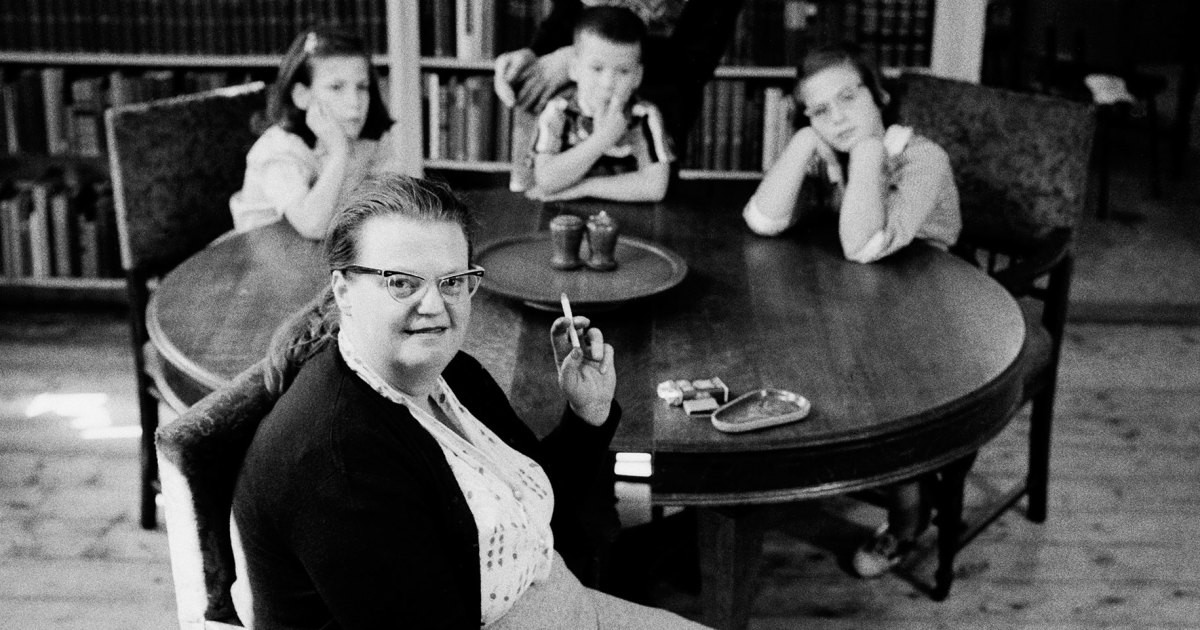interviews
The Growing Legend of Shirley Jackson
On the centenary of the horror icon’s birth, Doug Gordon and Ruth Franklin discuss legacies, witchcraft and a woman’s place.

December 14th marks the 100th anniversary of Shirley Jackson’s birth, which means Ruth Franklin’s new biography — Shirley Jackson: A Rather Haunted Life — couldn’t come at a more appropriate time. Jackson is arguably one of the most underrated writers of the 20th century, with “The Lottery” casting a long shadow over the rest of her superlative work. But in a conversation with Doug Gordon for To The Best of Our Knowledge — which is airing a special on the author’s life and legacy — Franklin makes a solid case for Jackson’s place in the cultural canon. As Franklin argues in her book, Jackson’s body of work channeled her era’s anxieties and represents “nothing less than the secret history of American women of her era.” What follows is a condensed and edited version of their conversation. You can find their full discussion, plus more on Shirley Jackson here.
Doug Gordon: Jackson had a heart attack and died in her sleep on August 8th, 1965. She was only 48. It’s one hundred years since she was born, in 1916. Why does Shirley Jackson’s fiction still matter?
Ruth Franklin: I think in some ways, Jackson’s fiction has always been in the background of our culture. There’s “The Lottery,” of course, which is a formative story for so many people. But The Haunting of Hill House and We Have Always Lived in the Castle are also very well-known, especially by writers. Those books have been very influential, not just on Stephen King, but on many other writers, including Neil Gaiman. Jonathan Lethem has referred to them and many other writers of a younger generation. So I think that the stories Jackson’s telling have somehow always been a part of our cultural history, and it’s only now that they’re starting to be recognized and given their due.
Gordon: I’m curious about how well you think Jackson’s fiction holds up today. Do you see any resonances between what she was writing about then, back in the 1940s and 1950s, and our current culture?
Franklin: Definitely. A lot of the circumstance for women have changed obviously. You know, it’s no longer a terrible thing to be a woman of 30 and unmarried, for instance, as it was in the story Jackson wrote, “The Daemon Lover,” about a woman of a certain age who is waiting for her fiancé to arrive. But while the subject matter of these stories isn’t as relevant to our current moment, her style and mood I think are still very, very accessible to readers today. Especially the ambiguity that was her trademark.
…As I began reading more and more deeply into Jackson’s work, I noticed that her characters are almost always women. You can count the male protagonists in her work literally on one hand. So she’s very, very focused on telling the stories of women. And they tend to be women on the margins in some way or other — working women in New York, career girls who are suffering the isolation of not having been married yet. Or women who have just been transplanted from the city to the suburbs and also don’t quite fit in among their neighbors. And it struck me that the stories Jackson was telling about these women who were uncomfortable in their skins and in the roles that they were being forced to play in society formed a kind of counterpart to what The Feminine Mystique describes as the attitude of the happy housewife that women were meant to embrace in those years. So I came to see it as a strong kind of counter narrative to what had been the mainstream story about American women.
Gordon: You mentioned Betty Friedan’s famous work. And you actually argue that Shirley Jackson’s portraits of “split women” predicts Friedan’s description of the 1950s housewife as a virtual schizophrenic.
Franklin: That’s right. Jackson depicts a number of women who suffer from different kinds of mental disintegration. One is a college student who develops something like schizophrenia, although it’s never exactly described as that, due to the pressure of her family’s expectations, her professors’ expectations, when she goes off to college.
Gordon: Hangsaman, right?
Franklin: Hangsaman, yes. Her third novel is called The Bird’s Nest and it’s actually about a woman with multiple personality disorder, written in the early ’50s at a time when that diagnosis was newly popular. And you know I read it as a kind of metaphor for what was going on in society when these women’s magazines ran a lot of stories arguing that you could be a housewife but you didn’t have to feel like you were just a housewife because you were also a cook and a nurse, a teacher and all the other roles that go into being a housewife and a mother. The stringency with which they promoted this idea suggests that their audience maybe didn’t find it so easy to swallow.
Gordon: And I’m guessing that it’s safe to say Shirley Jackson saw herself as one of these split women that she was writing about.
Franklin: I definitely would say so. I mean, you can see that split when she talks about herself as, you know, on the one hand, a housewife, and then, on the other, a writer. And then of course the other component of her personality was that she also spoke of herself as a witch. You know, as somebody who not only studied witchcraft, she also had a vast library of historical volumes related to witchcraft and to the occult. But also, as you know, she talked about herself as somebody who at times practiced witchcraft. And I see this as another kind of subversive aspect of her persona, another way in which she rebelled against the mainstream.
Gordon: The witchcraft though — some people, some critics have read too much into that because she was interested in witchcraft but she was kind of playing it up for publicity, like when she was talking to reporters. Isn’t that fair to say?
Franklin: Sure. Well, she loved to tell stories about her exploits and reporters just ate it up. There’s one line that went around about her. One reporter said she wrote not with a pen but with a broomstick, which was repeated over and over in articles and reviews of her work. She loved to tell another story about how she had supposedly broken the leg of publisher Alfred Knopf while he was in Vermont on a skiing trip.
Gordon: That was reported as fact and in future interviews, reporters would ask her about that?
Franklin: Exactly. He happened to be in a contract dispute with her husband at the time so there was a motive certainly. She liked to joke that she had to wait for him to go skiing in Vermont because she couldn’t practice witchcraft across state lines.
Gordon: That’s great. A great example of her sense of humor.
Franklin: Exactly.
Gordon: What kind of interest did Jackson have in witchcraft?
Franklin: I believe that she saw it as a way of channeling female power, as it always has traditionally been for women who feel themselves to be powerless. You know, she read it as she used to read tarot cards. I don’t believe she literally saw that as a way of telling the future, so much as simply a method of telling stories about people’s lives. And witchcraft also, you know, I think can be read mostly as a metaphor.
Gordon: That’s interesting. I was surprised to learn just how poorly Shirley Jackson’s mother, Geraldine, treated her, even when Shirley was an adult. Can you tell me a bit about their relationship?
Franklin: It seems like from the very beginning Shirley wasn’t the kind of daughter her mother had hoped to have. Her mother was a socialite from San Francisco and hobnobbed among the city’s elite. And Jackson really resisted her mother’s attempts to mold her into the kind of debutante that her mother wanted her to be. There’s actually a wonderful document in her archive — a childhood diary I found on a pad of paper that has on its cover the picture of a very demure, proper young lady with curls in her hair and pearls. And the title of the picture written underneath is “The Debutante.” And someone — I’m assuming that it might have been the teenage Shirley — had taken a pencil and scratched very heavily out the woman’s face. And to me that says so much about what Shirley’s feelings were about her mother trying to make her fit into this mold that she just didn’t belong into at all.
And so this difficult relationship actually continued for the rest of Shirley’s life, well into adulthood. Even though her mother lived in California and by that time, Shirley and her family were living in the Northeast in New York City and then in Vermont. Her mother would send her these simply poisonous letters of criticism, criticism of her looks and of her weight and of her work, you know criticizing her focus on what her mother called “demented girls,” with very few words of praise. And I think it was very hurtful.
Gordon: Oh, I can imagine it would be. So how did her mother’s poor treatment of her play out in Jackson’s fiction?
Franklin: Well, her fiction is full of kind of evil mother figures. For instance, in The Haunting of Hill House, the main character, Eleanor, is tormented by her memories of having taken care of her mother during a long illness. And her mother has just died when the novel begins and Eleanor has basically been a slave to her for her entire adulthood. And when she gets the chance to come to Hill House and join the paranormal investigation that’s taking place there, it’s really her first moment of freedom from her mother that she’s ever experienced. And yet she’s constantly plagued by nightmares about things that happened while she was taking care of her mother and the demands of their relationship. These relationships are repeated in a number of Shirley’s novels, where there are girls who have very difficult relationship with mothers who torment them in some way or another. Not physically tormenting them but what we would definitely call now psychological abuse.
Gordon: Shirley was finally able to escape her mother when she married Stanley Edgar Hyman. How did Shirley and Hyman meet?
Franklin: They met at Syracuse University where they both were studying English and journalism. The story goes that Stanley Hyman came upon a story by Shirley in a campus literary magazine. And he said the rest of the magazine was trash but when he got to Shirley’s story, he stopped short and declared that he wanted to meet the girl who’d written this story because he was going to marry her.
Gordon: Wow. Jackson’s 1959 novel, The Haunting of Hill House, is considered a classic haunted house story. It was actually nominated for the National Book Award, lost out to Philip Roth’s Goodbye Columbus. And you say that this novel, The Haunting of Hill House, is arguably Shirley Jackson’s best novel and that it’s on par with Henry James’ classic, The Turn of the Screw. Why do you think The Haunting of Hill House is such a great work?
Franklin: Well, for one thing, it is just beautifully written. The prose throughout is just so timeless and restrained but incredibly evocative. But more than that, you know, I think that when horror stories are told well, and you know maybe we’ll say ghost stories because horror has all kinds of other connotations. But when ghost stories are told well, as James does in The Turn of the Screw, they get to really deep reaches psychologically. I feel like the roots of what we fear can tell us so much about what it means to be a human and what goes on at the deepest levels of the human psyche. And what’s particularly brilliant about The Haunting of Hill House, and this is a quality again that it shares with The Turn of the Screw, is that you can never be entirely certain whether the ghosts are meant to be real or we’re meant to read them as a projection of the psyche of Eleanor, the main character. Or maybe you have another character, as well. It’s quite ambiguous.
The roots of what we fear can tell us so much about what it means to be a human and what goes on at the deepest levels of the human psyche.
Gordon: No less a horror authority than Stephen King has said that there are few, if any, descriptive paragraphs in the English language that are any finer than the opening paragraph of “The Haunting of Hill House”:
“No live organism can continue for long to exist sanely under conditions of absolute reality; even larks and katydids are supposed, by some, to dream. Hill House, not sane, stood by itself against its hills, holding darkness within; it had stood so for eighty years and might stand for eighty more. Within, walls continued upright, bricks met neatly, floors were firm, and doors were sensibly shut; silence lay steadily against the wood and stone of Hill House, and whatever walked there, walked alone.”
You say that Jackson’s obsession throughout her life was “the demon in the mind.” Can you explain what you mean?
Franklin: Yeah. Well, I think that she meant different things by this at different points in her life. At some points, she seems to have used it as a reference to depression and the sort of personal demons that tended to pop up when she was feeling particularly insecure. She also I think used it as a metaphor for a more general evil. She talked about, for instance, the demon in men’s minds in the wake of the McCarthy era as, you know, a kind of, just sort of a negative evil force in the universe, sort of like the negative force in “The Lottery,” which simply provokes people into harming one another.









